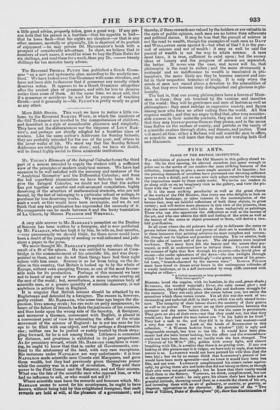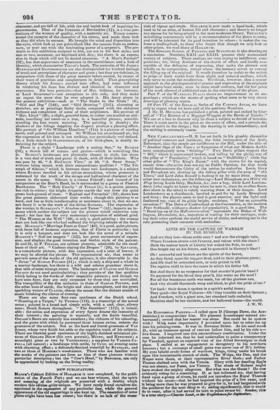FINE ARTS.
CLOSE OP THE BRITISH INSTITUTION.
THE exhibition of pictures by the Old Masters in this gallery closed to- day. On its first opening, we allowed ourselves just space enough to point out to the notice of our readers the most striking features of the collection, intending to give a more ample account of its beauties ; but the pressing demands of novelties have prevented our devoting sufficient space to such a detail, and we can now only solace ourselves by retracing the impressions made by these noble works. We invite our readers to go along with us on an imaginary visit to the gallery, and view the pic- tures with the " mind's eye."
It is the most striking peculiarity as well as the great charm of the works of the Old Masters, that every one who delights to look on a beautiful landscape, or takes interest in the contemplation of the human face, may see faithful reflections of both these objects, in great variety; and will derive more pleasure in this view of the pictures, than does the mere connoisseur, who looks at them exclusively as paintings. Those who can also appreciate the difficulties as well as the success of the art, and who can admire the skill and feeling of the artist as well as the beauty of the scene or object presented to them, will derive a two- fold gratification. In all cases where the old painters had only to delineate the scene or person before them, the truth and power of their art is wonderful. It is in these instances that painting achieves its most complete and success- ful, though not its highest and grandest triumphs. Yet we admire, both for the sake of nature and of the art. The old painters were inspired workmen. They must have felt the beauty and the scenes they por- trayed, as well as understood how to imitate them. CLAUDE drank in the streams of light that flow through his pictures—the fervid glow of sunset—the cooler splendours of the dawn—the dim twilight through which " far lands are seen tremblingly"—the green repose of his grace- ful trees, " branch-charmed by the earnest stars." GASPAR. POUSS1N must have loved to dream away hours in the umbrageous solitudes of a woody landscape, or in a dell surrounded by steep cliffs crowned with temples or villas- " A forked mountain or blue promontory With trees upon't."
HOBBLES& loved the coppice, with its hamlets, in the cool, green shade ; RUYSDAEL, the wooded waterfall ; CUYP, the calm sunset glow; REMBRANDT, the twilight stillness, when light and darkness strugle for the mastery. They not only place the scenes before you, but excite the sensations which those scenes create. Yet all this was the work of un. derstanding and technical skill in their art, which was only second to na- ture. The integrity of their labour shows the modesty of their genius as well as its power. They never set up their pretensions between the spectator and the scene before them. It was the same in portraiture. They gave no airs of their own—not that they could not, but that they
would not ; but placed the man before you " in his habit As he lived. They had a task to do, and they did it in their best manner—and a very fine one it was. Look at the heads of REMBRANDT in this
collection. A Woman looking from a window" (53) is ugly and disagreeable enough, but true to the life. It would have been plea- santer had she been better looking, but the effect and the vraisemblance col ld not have been finer, and we hardly wish the face changed. The " Portrait of his Wife" (85), golden with sunny light, and almost breathing with life, is a reality that there is no getting over. If any one looking at this picture says it is vulgar, we have only to reply, that human nature is so. LAWRENCE would not have painted his wife thus (had she been his); but we by no means think that LAWRENCE'S picture of her would have been more agreeable—and we know it would have been less like, and not true. LAWRENCE complimented his sitters rather equivo- cally, by giving them airs and looks that did not belong to them, as though their own were not good enough ; but he knew that their vanity would blind them to the flattery. VANDYKE, we think, complimented, but not at the expense of truth : he only gave. his sitters their best looks and a graceful attitude, throwing round them as a mantle the charm of his art, and investing them with an air of gallantry, or suavity, or gravity, or elegance, appropriate to the character. His portraits of the '‘ Two Sons of Villiers, Duke of Buckingham" (4), show fine discriminatioa of character, and are hill of 'life, with the real boyish look of inquiring in- gownaosness. That of the Countess of Devonshire (17), is a true por- traiture of the woman of quality, with a matronly air. TITIAN concen- trated the 'energies of the character of his sitters, and made them look as they did when in earnest. He brought the mind and disposition into the eyes, -which look at you point-blank like the cannon from an embra- sure, or peer out with the fascinating power of a serpent's. The por- traits in this exhibition assigned to him, are not in his best style; and one or two, moreover, are begrimed with dirt ; but there is an expres- sion in them which will not be denied attention. " A Man's Portrait" (97), has that appearance of exactness in the resemblance, and a look of identity, which characterize TITIAN'S heads. The portraits of Sir JOSHUA. REYNOLDS and GAINSBUROUGH. are also distinguished for kindred feelings of truth arid perceptions of character and grace ; but they are deficient, in comparison with those of the great masters before named, by reason of their want of precision and completeness in detail. That generalizing theory which Sir JOSHUA carried into effect, had some influence in rendering his faces less distinct and identical in character and expression. His best portraits—that of Mrs. Siddons, for instance, at Lord Grosvenor's—are exceptions to this rule, and they make us regret the more that he ever adopted it. His fancy pieces in the present exhibition—such as " The Snake in the Grass " (6), "Girl and Dog" (148), and "Girl Drawing" (151), charming as sketches, are as paintings flashy daubs, compared with the elaborate richness and completion of some of their neighbours. His portrait of "Mrs. Lloyd" (80), a slight, graceful form, in rather too studied an atti- tude, inscribing her name on a tree, is a beautiful picture, notwith- standing the face wants meaning. The painting is sketchy ; the shadows of the foliage dappling the drapery produce a pleasing effect. His portrait of "Sir William Hamilton" (114) is a picture of sterling merit, well painted and arranged. Sir William has an animated air, but the expression of his face is not striking, nor particularly well defined. 95, a little sketch by GAINSBOROUGII, of his birth-place, is doubly in- teresting for the subject.
There is a slight "Landscape with a setting Sun," by RUBENS (18), a sketch full of nature and genies—which is something like it. RVBENS'S landscapes are physically clumsy in style, but there is a vast deal of truth and gusto in them, with all their defects. Who can pass by 46, " A Bird's-eye View," or 50, "A Snow Scene," without being struck with their extraordinary qualities ? "The Tri- umph of Silenus," which is between these two landscapes, is a subject where RUBENS revelled in his sylvan sensualities, whose grossness is redeemed by the truth of the savage and half-animal character of the 'actors in the scene. Silenus is a vinous Falstaff; and instead of his companions at the Boar's Head, he is surrounded by a group of Flemish Bacchantes. The " Holy Family " of TITIAN (5), is a quaint picture, but rich in colour ; the bright draperies startle the eye from the quiet green back-ground of trees. "Raphael and Fornarina" (19), shows how the great painters elaborated their works ; though this painting is so hard, and has so little intellectuality or sentiment about it, that we can- not fancy it to be the work of the divine RAPHAEL. The expression of the woman in Guzactsro's " Absalom and Tamar" (52), imparts an in- terest which neither the subject nor the picture would otherwise com- mand : her face has the very momentary expression of subdued grief. " The Woman at the Well " (60), is only a good painting : the woman does not look like one who had suffered the forgiving rebuke of the Savi- our. MURILLO'S "Marriage Feast at Cana" (48), is a good, quiet picture, with faces full of humane expression, that of Christ in particular ; but it is only a banquet, and does not look like the scene of a miracle. Hotarcus's " Noli me tangere " (157), has great earnestness'of expres- sion, and displays the good intention and Gothic style of the painter. 25 and 31, by P. TIBALDI, are cabinet pictures, admirable for the excel- lence of their art. " Cadmus slaying the Dragon " (70), by SALVATOR, is a remarkable picture, with fine expression, avid a tone of horror, if we may be allowed the phrase. This supernatural air, that seems to pervade some of the works of the old painters, is also observable in the " Jonas "of GASPAR. POUSSIN (51); which is only a ship and a whale in a marine landscape, but there is a wild and solemn grandeur about it, that tells of some strange event. The landscapes of CLAUDE and GaseArs Poussiw do not need particularizing ; they partake of the fine qualities which belong to the works of their respective painters ; and though we have seen finer, they are only surpassed by those that are unrivalled. The tranquillity of the dim seclusion in those of GASPAR PousslN, and the sober hues of earth; the bright and clear atmosphere, and the green sparkling waters of CI.A.UDE, charm the senses like the distant sounds of music breaking the silence of evening. There are also some first-rate specimens of the Dutch school. " Shooting at a Target," by TENIERS (113), is a transcript of the actual scene ; painted in a broad and simple style, with a cool, clear, silvery tone ; Dutch Nature throughout. " The Gamblers" (117), is inimit- able: the action and expression of every figure denote the intensity of their interest ; the painting is masterly, and the finish beautiful. OSTADE'S Boors are scarcely less excellent ; the richness of his colouring, and the gusto with which he portrayed these human swine, redeem the grossness of the subject. Not so the hard and literal grossness of Vats STEEN, whose very finish but adds to the repulsive truth of his subjects. There are likewise good specimens of the highly-finished miniature pic- tures of GERARD Douw (his own portrait). MErzu, and NETSCHER; a moonlight piece or two by VANDERNEER; a sea-piece by VANDER CA• PELLA (all nature) ; a landscape with cattle, by CUYP, an evening scene with charming effect ; a delicately-finished waterfall by RUYSDAEL, and two or three of Homnsra's wood-scenes. Those who are familiar with the works of the painters can form an idea of these pictures without particular description; but the "Cow's Head," by BERGHEM, can only be appreciated by looking on the living reality.



























 Previous page
Previous page